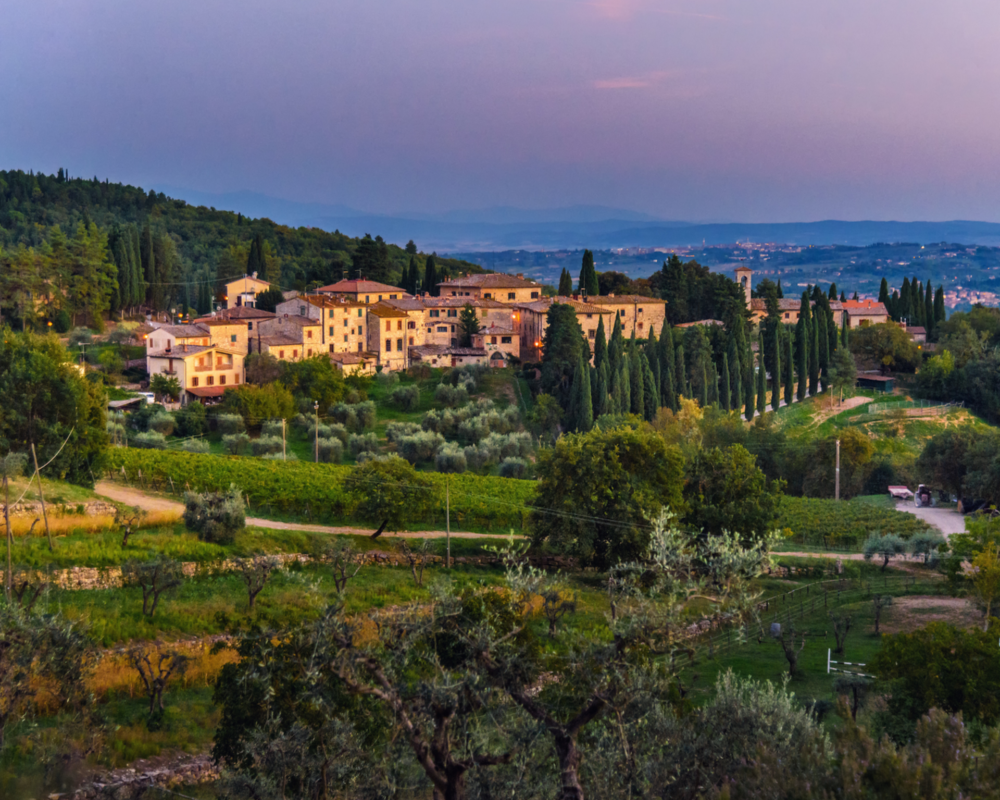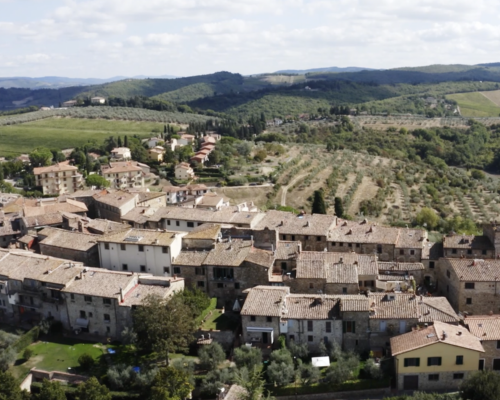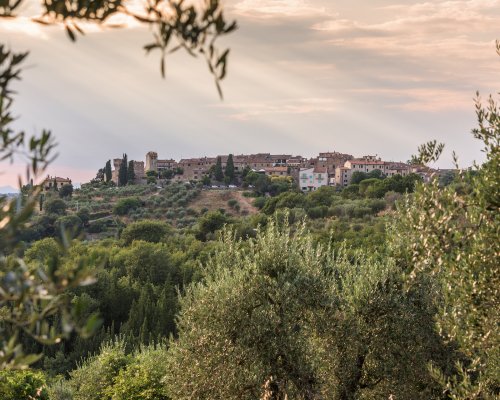Delightful Montefioralle or relaxing Volpaia: here's a look at 6 Chianti villages not to be missed
Charming stretches of vineyards alternate with olive groves and woods, among which you'll find historic medieval villages: the landscape of Chianti is one of the most famous in the world and never ceases to amaze.
Here, the land has a strong link with nature and everything has retained a quaint atmosphere, starting with the small villages, among which is the delightful Montefioralle, the characteristic San Gusmè, or the relaxing Volpaia.
Are you ready to leave behind the frenzy of everyday life? Follow us on this journey to discover 6 unmissable villages in Chianti!
Let's start from Montefiridolfi in San Casciano Val di Pesa. Like many other villages in Chianti, this one was built around the centuries-old castle which belonged to the sons of Ridolfo Buondelmonti, a family that owned it until the 17th century.
The village maintains its original structure, with the main square paved in terracotta tiles overlooked by the 14th century house-tower. Admire the historic castle standing near the village, and the Church of Santa Cristina.
Let's start from Montefiridolfi in San Casciano Val di Pesa. Like many other villages in Chianti, this one was built around the centuries-old castle which belonged to the sons of Ridolfo Buondelmonti, a family that owned it until the 17th century.
The village maintains its original structure, with the main square paved in terracotta tiles overlooked by the 14th century house-tower. Admire the historic castle standing near the village, and the Church of Santa Cristina.
A few kilometres south in Barberino Tavarnelle, we find ourselves in San Donato in Poggio. It has been known since the year 1000 for its parish church and castle, which can still be visited today.
The village is enclosed within the 13th-century walls, on which stands the watchtower called the “Torrino”. It's possible to reach the historical centre via the two historic gates: Porta Fiorentina (south-west) and Porta Senese (north-east).
The heart of the village is Piazza Malaspina, overlooked by Palazzo Malaspina, the Church of Santa Maria della Neve and the Palazzo Pretorio.
A few kilometres south in Barberino Tavarnelle, we find ourselves in San Donato in Poggio. It has been known since the year 1000 for its parish church and castle, which can still be visited today.
The village is enclosed within the 13th-century walls, on which stands the watchtower called the “Torrino”. It's possible to reach the historical centre via the two historic gates: Porta Fiorentina (south-west) and Porta Senese (north-east).
The heart of the village is Piazza Malaspina, overlooked by Palazzo Malaspina, the Church of Santa Maria della Neve and the Palazzo Pretorio.
Not far from Castellina in Chianti is Fonterutoli. It developed around the 15th-century village and was built on the ruins of the historic castle.
The Ancient Roman Fons Rutolae is one of the most important places in the history of Chianti: here Otto III, Emperor of the Holy Roman Empire, stayed for a short time with his court in 998, arranging a deed of the possessions of the Aretine Church with the Sienese Committee.
In 1202 and 1208 in the church of San Miniato, peace treaties were signed that defined the historical assignment of Chianti to the territory of the Florentine Republic. According to the tradition, two miles north of the village on the Via Romea Sanese in Croce Fiorentina, there was a meeting between the two knights in charge of establishing the borders between Florence and Siena, putting an end to the war between the two cities. During the last world war, the village hosted Giorgio La Pira, who wrote many of the texts that he later used in the Constituent Assembly while here.
Today, Fonterutoli maintains its medieval appearance while the castle, which became the villa of Marquis Mazzei, is a renowned accommodation and catering facility that organizes outdoor activities and wine experiences.
Not far from Castellina in Chianti is Fonterutoli. It developed around the 15th-century village and was built on the ruins of the historic castle.
The Ancient Roman Fons Rutolae is one of the most important places in the history of Chianti: here Otto III, Emperor of the Holy Roman Empire, stayed for a short time with his court in 998, arranging a deed of the possessions of the Aretine Church with the Sienese Committee.
In 1202 and 1208 in the church of San Miniato, peace treaties were signed that defined the historical assignment of Chianti to the territory of the Florentine Republic. According to the tradition, two miles north of the village on the Via Romea Sanese in Croce Fiorentina, there was a meeting between the two knights in charge of establishing the borders between Florence and Siena, putting an end to the war between the two cities. During the last world war, the village hosted Giorgio La Pira, who wrote many of the texts that he later used in the Constituent Assembly while here.
Today, Fonterutoli maintains its medieval appearance while the castle, which became the villa of Marquis Mazzei, is a renowned accommodation and catering facility that organizes outdoor activities and wine experiences.
The small fortified village of San Gusmè dominates the valley overlooking Siena, in the southernmost part of our tour. Not far from Castelnuovo Berardenga, its history began in the 14th century: the name probably derives from San Cosma, one of the patron saints, to whom the spectacular Church of Saints Cosma and Damiano is dedicated.
Today, it's still possible to see part of the mighty fortification walls that are partially incorporated into the houses of the village, with two entrance gates and the characteristic bell tower of Santissima Annunziata.
Don't leave the village without admiring the statue of Luca Cava. It depicts a man intent on his physical needs, and the inscription "King, emperor, pope, philosopher, poet, farmer and worker: man in his daily functions. Don't laugh, think about yourselves". A local festival is also dedicated to Luca Cava, taking place in early-mid of September.
The small fortified village of San Gusmè dominates the valley overlooking Siena, in the southernmost part of our tour. Not far from Castelnuovo Berardenga, its history began in the 14th century: the name probably derives from San Cosma, one of the patron saints, to whom the spectacular Church of Saints Cosma and Damiano is dedicated.
Today, it's still possible to see part of the mighty fortification walls that are partially incorporated into the houses of the village, with two entrance gates and the characteristic bell tower of Santissima Annunziata.
Don't leave the village without admiring the statue of Luca Cava. It depicts a man intent on his physical needs, and the inscription "King, emperor, pope, philosopher, poet, farmer and worker: man in his daily functions. Don't laugh, think about yourselves". A local festival is also dedicated to Luca Cava, taking place in early-mid of September.
Time seems to have stopped in this small fortified village in Radda in Chianti.
Formed around the historic castle with its characteristic tower and surrounded by vineyards, here you can enjoy the tranquility of its alleys, admiring the church of San Lorenzo and the square with its well.
Don’t forget to stop in one of the many wineries in the area to discover how Chianti Classico is produced and enjoy a delicious tasting.
Time seems to have stopped in this small fortified village in Radda in Chianti.
Formed around the historic castle with its characteristic tower and surrounded by vineyards, here you can enjoy the tranquility of its alleys, admiring the church of San Lorenzo and the square with its well.
Don’t forget to stop in one of the many wineries in the area to discover how Chianti Classico is produced and enjoy a delicious tasting.
Ranked among the most beautiful villages in Italy, a few kilometers from Greve in Chianti, Montefioralle is a true gem with narrow streets and stone houses overlooking the hills of Chianti.
Walking along the main street, admire the coats of arms and family crests, looking to spot the house that was owned by the last member of the Vespucci family, Americo Cesare, who died in 1875 and is buried in the local cemetery.
Don't forget the traditional festivals such as the Frittelle per San Giuseppe (Pancakes for St. Joseph) and I Vini del Castello (The Wines of the Castle), an ecological event that attracts the main producers of Chianti Classico.
Ranked among the most beautiful villages in Italy, a few kilometers from Greve in Chianti, Montefioralle is a true gem with narrow streets and stone houses overlooking the hills of Chianti.
Walking along the main street, admire the coats of arms and family crests, looking to spot the house that was owned by the last member of the Vespucci family, Americo Cesare, who died in 1875 and is buried in the local cemetery.
Don't forget the traditional festivals such as the Frittelle per San Giuseppe (Pancakes for St. Joseph) and I Vini del Castello (The Wines of the Castle), an ecological event that attracts the main producers of Chianti Classico.


